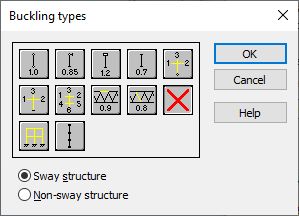This option is used to define the buckling length of members. It is made available by pressing the appropriate icon (for the Y or Z direction) found in the Buckling Length Coefficient field of the Member Definition - Parameters dialog box.

The buckling length coefficient is entered automatically once one of the icons with the appropriate end support conditions is selected. The icons are divided into two groups: the first one contains typical (code) methods of member support and the corresponding buckling coefficient values, whereas the other one - contains icons for calculating the buckling coefficient for columns of multi-story frames (calculation of buckling length coefficient for one, three and six adjoining members).
Double-clicking on one of the icons which signify calculation of the buckling length coefficient (![]() ,
, ![]() ,
, ![]() ) opens the additional dialog box.
) opens the additional dialog box.
Buckling is always considered in calculations when a compressive force acts on a member, even if it is insignificant in relation to other internal forces. The program does not analyze if the buckling effects may be disregarded or not. If the user wants to exclude buckling effects from calculations, the ![]() icon must be selected. This indicates the exclusion of buckling from the calculation process.
icon must be selected. This indicates the exclusion of buckling from the calculation process.
The last icon ![]() allows the user to consider bars with internal bracings (lateral stiffening of the analyzed bars, limiting the lateral buckling length) in calculations. After double-clicking on the icon, the Internal bracings dialog box opens on the screen, in which parameters of lateral stiffening may be determined.
allows the user to consider bars with internal bracings (lateral stiffening of the analyzed bars, limiting the lateral buckling length) in calculations. After double-clicking on the icon, the Internal bracings dialog box opens on the screen, in which parameters of lateral stiffening may be determined.